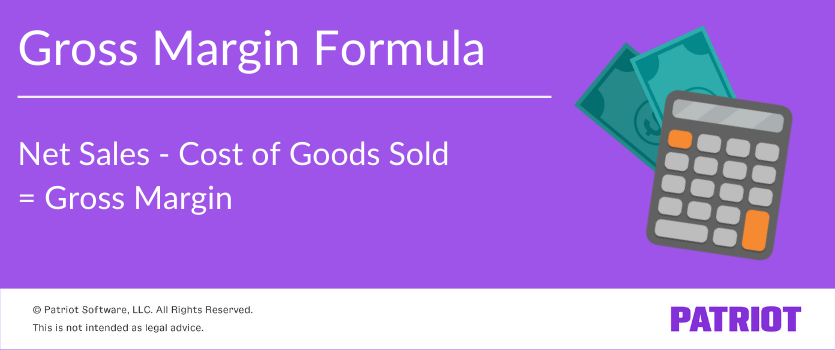As a business owner, you calculate a variety of figures to determine your company’s financial health. One of these figures to keep on your radar is gross margin. Read on to learn what is gross margin and how it can help you set prices for your goods or services.
What is gross margin?
Gross margin is your business’s net sales minus your cost of goods sold (COGS). Basically, gross margin is the revenue your company has after incurring direct costs from producing your goods or services.
Your net sales show the revenue your business makes after deducting things like discounts, returns, and allowances from your profits. To find net sales, subtract deductions (e.g., discounts) from your gross sales.
Cost of goods sold is how much it costs to produce your products or services. Your COGS can include things like direct materials and direct labor expenses. To calculate your COGS, add your beginning inventory and purchases during the period together. Then, subtract your ending inventory.
Check out the gross margin formula below:
Gross Margin = Net Sales – Cost of Goods Sold
The higher your gross margin is, the more efficient your business is at producing its goods and services.
Gross margin represents the portion of each dollar your business retains. For example, if your gross margin is 40%, you are earning $0.40 for each dollar of revenue you earn.

Gross margin vs. net margin
If you’ve heard of net margin before, you might be wondering, What’s the difference between gross margin and net margin?
Unlike gross margin, net margin includes all of your business’s expenses, not just the expenses related to your COGS. When you calculate your net margin, you must subtract your COGS as well as administrative, financial, and other expenses from your net sales.
Gross margin helps your company assess the profitability of your manufacturing activities, while net margin helps you calculate your company’s overall profitability.
How to calculate gross margin: Examples
How do you find gross margin? Using the formula from above, let’s take a look at some examples of calculating gross margin. As a reminder, this is the gross margin formula:
Gross Margin = Net Sales – Cost of Goods Sold
Example 1
Say your business’s net sales for the year are $50,000. Your cost of goods sold is $20,000.
Gross Margin = $50,000 – $20,000
Your business’s total gross margin dollars are $30,000. This means after you subtract how much it costs to produce your products or services, you’re left with $30,000.
Some businesses prefer to see their gross margin as a percentage instead of a dollar amount. To convert your gross margin to a percentage, use the following formula:
Gross Margin = [(Net Sales – Cost of Goods Sold) / Net Sales] X 100
Using the same numbers from above for net sales and COGS, you can calculate your business’s gross margin as a percentage.
Gross Margin = [($50,000 – $20,000) / $50,000] X 100
Your gross margin on sales for the year as a percentage is 60%. This means your business has 60% of its revenue left over after it pays direct costs (cost of goods sold).
Example 2
Let’s say you own a T-shirt business. You sell each T-shirt for $30. Your COGS is $15 per shirt.
Gross Margin = $30 – $15
Gross Margin (Percent) = [($30 – $15) / $30] X 100
Your gross margin for each T-shirt you sell is 50%. This means you have half of your revenue left over after you factor in cost of goods sold.
How to improve your gross margin
Ideally, the higher your gross margin is, the better off your business will be. For example, you would rather have a 70% gross margin vs. a 15% gross margin because it means you have higher profits.
Keep in mind that gross margins vary from business to business and can also vary depending on your industry. And, remember that gross margins are generally lower for startups.
If you’re looking to increase your gross margin, you can:
- Increase prices
- Reduce direct costs (COGS)
- Decrease inventory waste
- Adjust your offerings
- Add new services or products
Importance of understanding gross margin
Your gross margin can tell you a number of things. It can show you that your COGS is too high, pricing is too low, or offerings need an update or change.
Many business owners fail to recognize the significance of their gross margin, especially new startup owners that don’t have as much financial experience.
Calculating your business’s gross margin can help you:
- Evaluate profitability
- Save money
- Determine your break-even point
Knowing your business’s gross margin is essential in assessing your profitability. Calculating gross margin lets you see how much profit you make after you factor in your cost of goods sold. Without your gross margin, you wouldn’t know how profitable your business is and whether or not you need to make adjustments to prices or direct costs.
If you’re looking to save money, your gross margin can help. As you saw in one example, you can calculate gross margin on a per-product basis. Calculating gross margin can show you if you’re spending too much time or labor on a certain product or service. Having your gross margin can help you make decisions that will keep your costs lower and improve your profits in the long run.
To know your company’s break-even point, utilize your gross margin. Your break-even point is the amount of revenue you need to earn in order for your total sales to equal total expenses. For example, if your business expenses total $50,000 and your gross margin is 50%, you would need to make $100,000 to cover your costs and break even.
On the hunt for an easy way to track your business income and expenses? Patriot’s accounting software is straightforward and lets you streamline the way you manage your books. Try it for free today!
This article has been updated from its original publication date of March 6, 2015.
This is not intended as legal advice; for more information, please click here.



